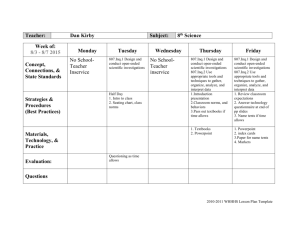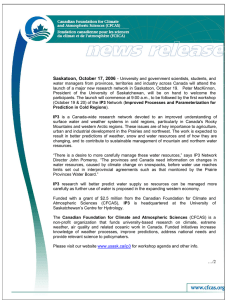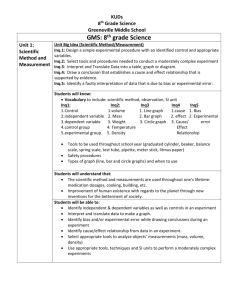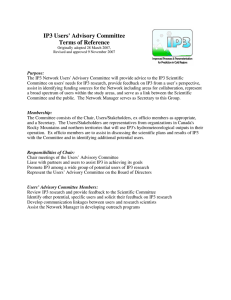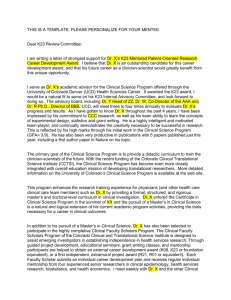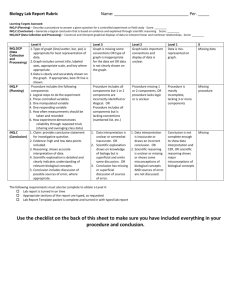Improved Processes and Parameterisation for Prediction in Cold Regions
advertisement
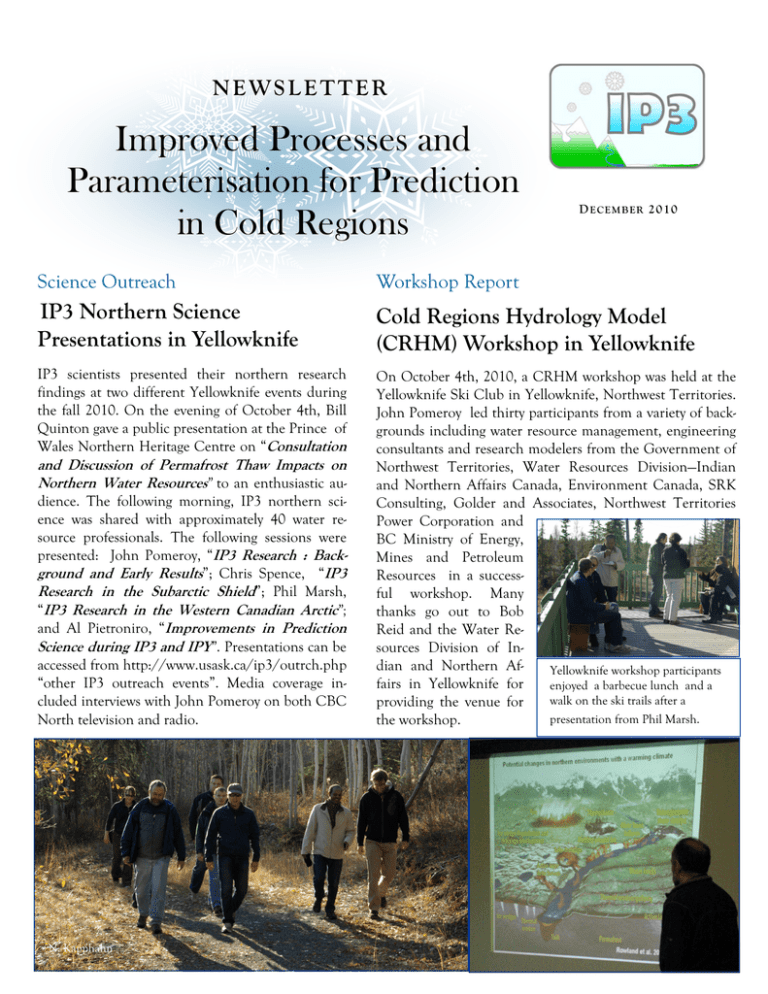
NEWSLETTER Improved Processes and Parameterisation for Prediction in Cold Regions D EC EM B ER 2 0 1 0 Science Outreach Workshop Report IP3 Northern Science Presentations in Yellowknife Cold Regions Hydrology Model (CRHM) Workshop in Yellowknife IP3 scientists presented their northern research findings at two different Yellowknife events during the fall 2010. On the evening of October 4th, Bill Quinton gave a public presentation at the Prince of Wales Northern Heritage Centre on “Consultation On October 4th, 2010, a CRHM workshop was held at the Yellowknife Ski Club in Yellowknife, Northwest Territories. John Pomeroy led thirty participants from a variety of backgrounds including water resource management, engineering consultants and research modelers from the Government of Northwest Territories, Water Resources Division—Indian and Northern Affairs Canada, Environment Canada, SRK Consulting, Golder and Associates, Northwest Territories Power Corporation and BC Ministry of Energy, Mines and Petroleum Resources in a successful workshop. Many thanks go out to Bob Reid and the Water Resources Division of Indian and Northern AfYellowknife workshop participants fairs in Yellowknife for enjoyed a barbecue lunch and a walk on the ski trails after a providing the venue for presentation from Phil Marsh. the workshop. and Discussion of Permafrost Thaw Impacts on Northern Water Resources” to an enthusiastic audience. The following morning, IP3 northern science was shared with approximately 40 water resource professionals. The following sessions were presented: John Pomeroy, “IP3 Research : Background and Early Results”; Chris Spence, “IP3 Research in the Subarctic Shield”; Phil Marsh, “IP3 Research in the Western Canadian Arctic”; and Al Pietroniro, “Improvements in Prediction Science during IP3 and IPY”. Presentations can be accessed from http://www.usask.ca/ip3/outrch.php “other IP3 outreach events”. Media coverage included interviews with John Pomeroy on both CBC North television and radio. N. Kapphahn IP3 Photo Contest Winners IP3 held a photo contest last summer with the goal of encouraging participants to contribute their photos to the IP3 legacy archive as the network wraps up its research. Entries were not as numerous as we had hoped so the Scientific Committee elected to combine the categories into one and choose an overall first prize winner, two second prize winners, and three third prize winners. Prizes were awarded to Jim MacDonald—University of Saskatchewan for first prize, Jocelyn Hirose–University of Calgary and Clay Morgan—Wilfrid Laurier University for second prize and Jocelyn Hirose, Jim MacDonald and Scott Munro – University of Toronto for third prize. 1st Prize Mike working on Fisera Ridge, Marmot Creek Jim MacDonald University of Saskatchewan 2nd Prize Rainbow over First Lake Scotty Creek Clay Morgan Exposed annual layers of ice and seasonal snow—Opabin Glacier Jocelyn Hirose Wilfrid Laurier University University of Calgary Page 2 IP3 Newsletter 3rd Prize Taking down the weather station on Opabin Jocelyn Hirose Peyto Glacier Scott Munro University of Toronto Stream transect, Marmot Creek Jim MacDonald University of Saskatchewan Thank you to all those that sent in photos. All photos entered in the contest can be seen at http://www.usask.ca/ip3/gallery.php Improved Processes and Parameterisation for Prediction in Cold Regions Page 3 Partnership Activities IP3 Partners with Backcountry Energy Environmental Solutions (BEES) IP3 will be publishing the final newsletter for the network in March 2011. We would welcome articles from all members of the IP3 community including investigators, collaborators, students and users of IP3 science. Please send all articles and ideas (with photos!) to nadine.kapphahn@usask.ca Course Offering A joint project to install meteorological stations brought Backcountry Energy Environmental Solutions (BEES) and IP3 together. On a cool and snowy September 1st, 2010, John Pomeroy, Karen Rollins, and Jon Rollins flew by helicopter up to Campbell Icefield Chalet, 20km NW of Golden B.C. They erected a ten-foot mast and attached an anemometer and sensors to measure temperature and relative humidity. Two days later, under sunnier and much more pleasant conditions, the team set up an eighteen foot mast with similar equipment on a ridge above Valhalla Mountain Lodge, near Nakusp, B.C. BEES initiated this project to gain information about wind speed and wind direction in order to find a suitable location for its wind turbine demonstration project. BEES is a non-profit collaborative initiative formed to find solutions for energy, water and waste at alpine recreational facilities that are off the grid Campbell Icefield (www.beeshive.org). The collected data will also benefit IP3 in adding to the general pool of alpine meteorological information. May Guan of IP3 also provided technical support for this project, as well as assisting BEES with retrieving an anemometer from the Alpine Club of Canada’s Bow Hut earlier in AuJ. Pomeroy gust. Canadian Society of Hydrological Sciences Short Course: Physical Principles of Mountain and Cold-Climate Hydrology After the success of the inaugural short field course held at Kananaskis in March 2010, the University of Saskatchewan and the Canadian Society for Hydrological Sciences is again offering an intensive short course on “The Physical Principles of Hydrology in Mountainous and Cold-Climate Settings”. The course will take place at the University of Calgary’s Biogeoscience Institute’s Barrier Lake Station in the Kananaskis Valley, near Calgary, Alberta, Canada, from February 28 to March 11, 2011. The course is intended for researchers and practitioners in hydrology and water resources, including graduate students and junior to intermediate water resource engineers, hydrologists, aquatic ecologists and technologists; and is suitable for those either working directly in hydrology and water resources, or looking to broaden their understanding of hydrological systems and processes. Classroom sessions will be supplemented with field sessions at Marmot Creek Research Basin and other local sites. The course held last March ran at capacity with 40 participants, so please register early! Registration deadline is February 7, 2011. Page 4 IP3 Newsletter Science Outreach Upcoming Workshops • • The IP3 Network, as part of the International Association of Hydrological Sciences (IAHS) Predictions in Ungauged Basins (PUB) movement is planning a workshop entitled “Putting PUB into Practice” to be held in Canmore, Alberta from the 10th to the 14th of May 2011 (immediately prior to the Canadian Geophysical Union’s annual meeting in the neighbouring town of Banff). The principal goal of the meeting is to make progress towards a crystallization of “state of the art” PUB research, in order to facilitate its encapsulation in tools which contribute directly to the solution of real-world challenges in water resources management. The goal includes bringing together a broad cross-section of researchers, practitioners and toolset developers with interests in this field. The workshop will consist of presentations by a series of invited speakers with expert knowledge in specific aspects of PUB, augmented by break-out group discussions, and poster sessions. Information on the organization and content of the workshop are available at iahs-pub.org/pub2011/. Call for papers for the annual meeting of the Canadian Geophysical Union and Canadian Society of Agricultural and Forest Meteorology to be held May 15-18 in Banff , Alberta with the theme “Geophysical Sciences for the Future”. Abstracts are solicited in Geodesy, Hydrology and Biogeosciences and other Geophysical areas with a deadline of February 15, 2011. Information on preparation and submission details is available from the conference website at http://people.ucalgary.ca/~cguconf/. IP3 in Action • • • “Water - Destitute Future?”, an interview with John Pomeroy, was published in the Fall 2010 issue of the University of Saskatchewan Arts and Science Alumni news magazine and can be accessed from http://artsandsciencelists.usask.ca/ attachments/3856/DiversitA_S2010_web-1.pdf. John discusses the importance of water research to the Prairie provinces and the importance of funding this work. A panel discussion for the University of Toronto’s Geography and Planning Fall 2010 Speaker Series featured Sean Carey—IP3 Processes Theme Leader as part of “A Panel Discussion on the Athabasca Tar Sands” where he shared his expertise as a cold regions hydrologist in discussing the hydrology of reclaimed mine sites. John Pomeroy gave a seminar at the University of Waterloo’s Water Institute in November 2010, entitled “Advancing Hy- IP3 research has been completed and work on incorporating parameterisations into the MESH and CRHM models will be completed over the next 8 months. IP3 will be holding a workshop and seminar event in September, 2011 to share final model results with the larger IP3 community. More information will be available in the March newsletter. drological Processes to Better Predict Water Resources in Canada” which identified IP3’s contributions to reducing the uncertainties in the prediction of streamflow in ungauged basins. An abstract of the presentation is available at http:// www.usask.ca/ip3/download/Pomeroy_Seminar_Nov4.pdf. Improved Processes and Parameterisation for Prediction in Cold Regions Page 5 Ongoing Research Hydrology of discontinuous permafrost: Effects of permafrost plateau geometry on subsurface drainage Actual plateau Hydrological equivalent plateau 1 Fraction of Total Water Drained from Plateau Brendan Christensen, an MSc student at the University of Calgary, is studying the subsurface hydrology of wetland dominated discontinuous permafrost under the supervision of Dr. Masaki Hayashi. Initial research has focused on determining runoff timing and volume from the geometric properties of peat plateaus within the Scotty Creek research basin. Peat plateaus in the wetland dominated discontinuous zone are underlain with permafrost, and are slightly elevated above the surrounding flat bogs and channel fens. Runoff from these plateaus occurs through the thawed active layer, overtop of the impermeable permafrost boundary (see Figure 1). As the subsurface drainage from these plateaus is a major contributor of runoff into the basin, the evolving permafrost regime 0.9 0.8 0.7 0.6 0.5 0.4 0.3 0.2 0 -6 10 Figure 1: Conceptual model of runoff from peat plateaus. Runoff occurs through the thawed active layer along the impermeable permafrost boundary. is expected to have a significant effect on a basin’s overall hydrological responses. To quantify this effect, Brendan has been using numerical modeling to simulate plateau runoff. The irregular shape, size and distribution of these plateaus make modeling of this complex system as a whole impractical, so a relationship between a plateau’s physical geometry and its hydrological properties was developed (see Figure 2). Using this method, the statistical distribution of plateaus Equivalent Plateau Actual Plateau 0.1 -4 10 -2 10 0 10 Time [days] 2 10 4 10 Figure 2: Comparison of simulated plateau runoff between an actual plateau and its hydrological equivalent. within a basin, along with the geometric properties of the plateaus can be combined to develop a basin hydrological response. Brendan’s future research will combine plateau runoff with runoff routing to develop an overall basin response. Water level transducers have been deployed throughout the Scotty Creek basin to quantify the routing response, and groundwater piezometer nests have been installed to account for the groundwater contribution. IP3 Outreach is available for setting up cold regions model training sessions or meetings between scientists and users for sharing of information. Informational brochures are available for public distribution, including brochures on IP3 research focused in the north, IP3 research in the mountain watersheds, and an overview of the Cold Regions Hydrological Model (CRHM) and its structure and specifications. Information in this issue submitted by John Pomeroy, Brendan Christensen, Karen Rollins, Michael Allchin and Nadine Kapphahn For more information or to contribute an article—please contact Nadine Kapphahn nadine.kapphahn@usask.ca
